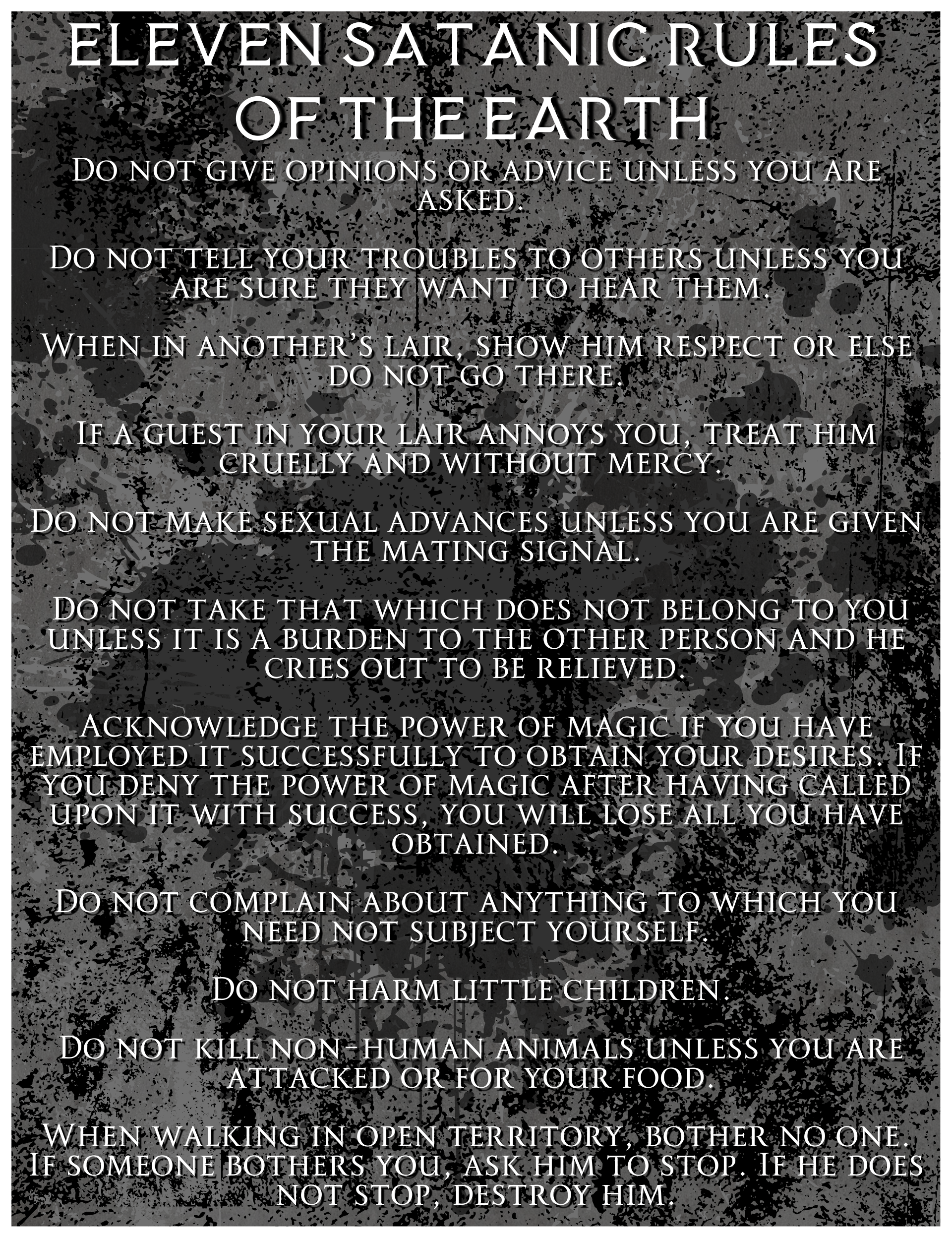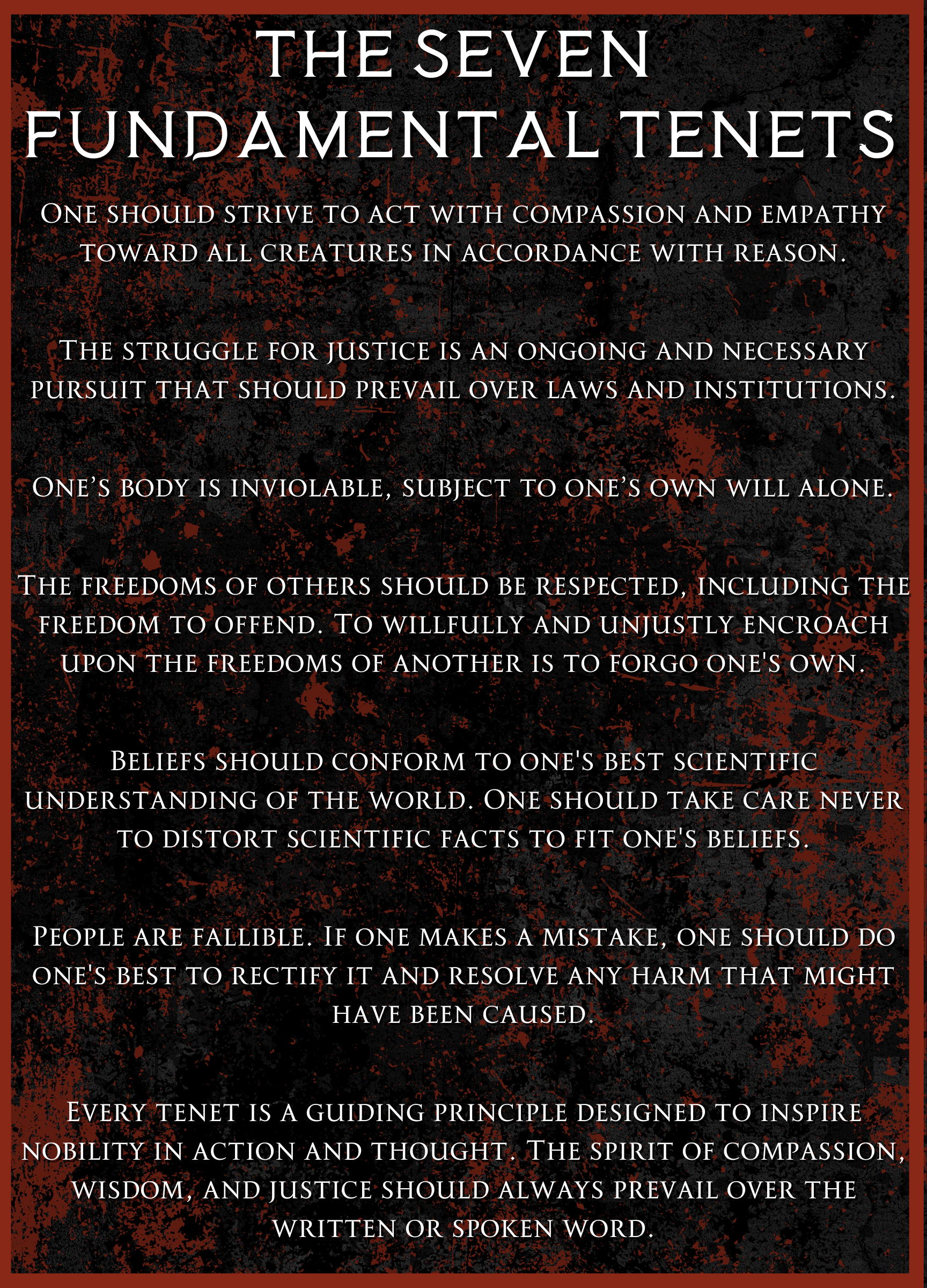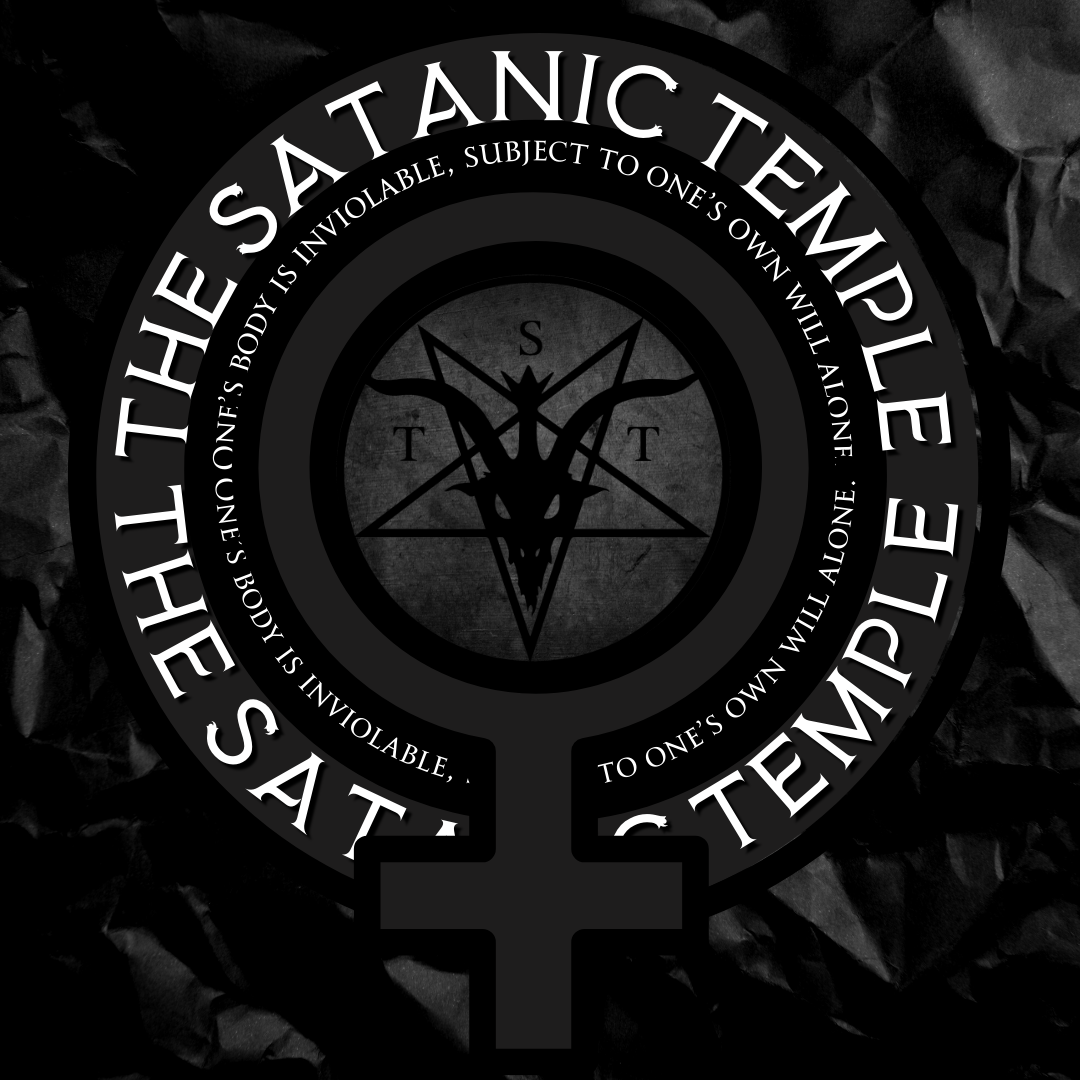The Satanic Temple has become the primary religious Satanic organization in the world, with congregations internationally, and a number of high-profile public campaigns designed to preserve and advance secularism and individual liberties. The rise of The Satanic Temple has been met with an increase in commentary regarding what Satanism is as media outlets struggle to grasp how this upstart religion has begun to shift religious liberty debates with mere claims of equal access.
With unfortunate regularity, The Satanic Temple is confused with an earlier organization, the Church of Satan, founded by Anton Szandor LaVey in the 1960s, to the apparent chagrin of both. The Church of Satan expresses vehement opposition to the campaigns and activities of The Satanic Temple, asserting themselves as the only “true” arbiters of Satanism, while The Satanic Temple dismisses the Church of Satan as irrelevant and inactive.

Infographic by Pope Wonka. “Blue Cheese fact” from “the LaVey Salad Dressing Test”, The Satanic Witch, 1971
On the surface, some differences between the two organizations are immediately apparent: the Church of Satan fashions itself the inheritor of LaVey’s legacy, paradoxically claiming his philosophy of individualism a collective achievement for which they rest upon the laurels. Aside from an active Twitter feed, whereon the Church of Satan posts catchy memes and commentary upon popular culture references to Satan, the Church of Satan is otherwise inactive as an organization, arguing that as individualists, it is upon the individual merits and achievements of their membership that their collective reputation should be measured. The Satanic Temple, on the other hand, is very active in public affairs. Unlike the Church of Satan, The Satanic Temple has a physical headquarters in Salem, Massachusetts, holds two virtual Temple services each week, and numerous active congregations throughout the world.
The Church of Satan dedicates a good deal of time offering disparaging commentary against The Satanic Temple’s activities on the assertion that “true Satanism” is apolitical, and whether or not they agree with any of our positions, they object nonetheless to what they see as a misappropriation of Satanism. In doing so, they fail to delineate the clear philosophical differences between the two organizations, and many people are unaware that the beliefs of the two aren’t merely interchangeable. Perhaps due to the popularity of The Satanic Temple, one is hard pressed to find the Church of Satan commenting on the philosophical schism between the organizations, instead opting to forward the notion that The Satanic Temple has merely stolen what they see as their brand, as well as their beliefs.
The following essay is a guide to understanding the philosophical differences between The Satanic Temple and the Church of Satan so as to give the reader a clear understanding of the “Satanic Reformation” instigated by The Satanic Temple’s work. As this essay is only meant to illustrate the differences between the two organizations, it can not be said to be a full analysis of the beliefs of either. For those unaware of the beliefs of either organization, The Satan would refer you to the websites of each, and he would particularly recommend the essay“SATANISM: THE FEARED RELIGION”(and the hyperlinks preceding that essay) by current Church of Satan head Peter Gilmore, for an understanding of what Satanism means to the Church of Satan, and his own INTERVIEW WITH HAUTE MACABREfor an understanding of Satanism means to The Satanic Temple.
EVOLUTION AND THE CULTURE WAR
The irreconcilable claims regarding human origins which pit science against religion are often apparent even to young children. Dinosaurs are conspicuously absent from Adam and Eve’s early Earth, nor does the Book of Genesis allow any credible interpretive space for our hominid ancestors. Many non-believers cite their early recognition of this dissonance — and the outrage or unsatisfying evasions they witnessed in religious teachers when this sensitive topic was exposed to inquiry — as their first venture into the critical scrutiny that would lead them to resolute atheism.
Zealots, of course, fight mightily against biology’s well-established unifying theory having representation in school curriculums. Aware that biblical literalism and Evolution can’t coexist, fundamentalists rightly treat Darwinism as an existential threat. The cultural war between creationist evangelicals and the scientifically literate has been a defining element of the American social backdrop for generations, a zero-sum war over textbooks and teaching standards which determines whether our children are to grow in an environment of uncorrupted pious ignorance, or be subjected to the defilement of their spiritual sanctity by Darwinist damnation.
The violence done to the biblical creation myth by darwinian theory can only be accounted for in the faith-addled fundamentalist’s mind as a calculated Satanic attack upon God, Church, and the entire moral fabric of civilization. From a contemporary vantage point, the conflict between Abrahamic faith and Science, believers and nonbelievers, supernaturalists and rationalists, is centered upon the division between Creationism and Evolution. From these disparate foundational origin claims come conflicting answers regarding human morality, sexuality, social order, and the nature of reality itself. To the Creationist, complex emergent biological and social systems defy even millions of years of cumulative “random chance” selections. To them, our current biological forms were constructed all at once, by a divine consciousness, and our moral obligations are dictated to us, by this supreme and timeless being, in a series of conflicting literary works arbitrarily culled together into “the” Bible… The voice of God which tells us to subdue our baser, primal, carnal instincts — Satanic temptations — for a transcendent purity which grants a blissful (though possibly still sexless) eternal afterlife.
Those who accept evolution also must accept that our moral sense is a byproduct of its blind processes, and it wasn’t long following the publication of On the Origin of Species that philosophers of Evolutionary Morality began to assert overreaching claims for a “social Darwinism” that purported to explain human behavior in evolutionary terms. Social Darwinism is DEFINED AS“ the theory that human groups and races are subject to the same laws of NATURAL SELECTION as CHARLES DARWINhad perceived in plants and animals in nature. According to the theory, which was popular in the late 19th and early 20th centuries, the weak were diminished and their CULTURES delimited while the strong grew in power and in cultural influence over the weak. Social Darwinists held that the life of humans in society was a struggle for existence ruled by ‘survival of the fittest,’ a phrase proposed by the British philosopher and scientist HERBERT SPENCER.”
From the social darwinist perspective, charity for the “weak” diminishes the overall well-being of the population, propagating dysfunctions that would otherwise eradicate themselves if only allowed to perish in natural conditions. The seeming brutality of this position is believed to be offset by a sense of compassion for the “greater good,” the long-term integrity of the human gene pool. Physical disease, as well as mental incompetence, survive and propagate within a culture of misguided sympathy that preferences these conditions with counterproductive humanitarianism.
DARWIN AND SATAN
Anton LaVey, editor of a book he entitled “The Satanic Bible,” embraced social darwinism as the scientific counterpoint to what he saw as Christianity’s imposition of a deleterious illusion of altruism. While traditional social darwinists arbitrarily categorized people into groups and races, often as means for justifying colonialism and racism, LaVey focused solely on the merits of the individual, judged upon talent, intelligence, and contribution, rather than pedigree. To LaVey, the post-Nazi era renunciation of social darwinist ideals was an example of “throwing out the baby with the bathwater.” Each individual, according to LaVey, is a self-interested animal.
The individualist social darwinist philosophy is the core of LaVeyan Satanism. LaVey himself once described his conception of Satanism as “just Ayn Rand’s philosophy with ceremony and ritual added.” While nontheistic in his treatment of Satan, ostensibly regarding the Adversary not as a personal deity, but as a metaphor for rebellion, LaVey’s belief in the power of magic was artfully, and probably intentionally, unclear in his writings. He denied that the power of magic, which he believed was harnessed through rote pageantry in the “ritual chamber,” could be described as supernatural as opposed to merely as-yet unexplained by science. However, LaVey’s own descriptions of MAGICAL SUCCESSES, from deadly hexes to unexplained healings, were as scientifically unjustified as any supernatural claims to magical influence. Even LaVey’s nontheism is uncertain. Upon his death, his partner and biographer, Blanche Barton, insisted that LaVey did, in fact, “believe in the devil.”
“HE DID BELIEVE IN THE DEVIL,” insisted Barton, a blonde woman who is the mother of LaVey’s [then] four- year-old son, Xerxes. “He believed in magic. He practiced it religiously.” [1]
From a purely materialist perspective, it is hard to accept the seventh of LaVey’s “Eleven Satanic Rules of the Earth” which states that one must “[a]cknowledge the power of magic if you have employed it successfully to obtain your desires. If you deny the power of magic after having called upon it with success, you will lose all you have obtained.”

Tone Deaf: The Church of Satan began marketing an anti-equality polo shirt in March 2015, just 3 months before the Supreme Court legalized gay marriage
(HTTPS://WWW.CHURCHOFSATAN.COM/INEQUALITY-POLO-SHIRT-ASP-APPAREL-SATANIC/)
While LaVey did not endorse the racialization of social darwinist theory, he did differentiate the individual against the never-very-clearly-defined “masses” — the dehumanized herd against whom an “alien elite” of Satanic superiors must fight to maintain their distinction. LaVey endorsed stratification — the first of his five-point program of “goals/guidelines that are clear, concrete, and that will effect significant changes” and “[t]he point on which all the others ultimately rest” — though he never set any clear delineations upon which his stratification would be premised, only stating, “No one should be protected from the effects of his own stupidity.” Equality, LaVey proclaimed, “only translates to ‘mediocrity’ and supports the weak at the expense of the strong. Water must be allowed to seek its own level without interference from apologists for incompetence.”
THE MASSES
In his disdain for “the masses,” LaVey mirrored the opinions of another of his primary influences, Friedrich Nietzsche, whose message in The Will to Power was that a “declaration of war on the masses by higher men is needed” because “[e]verywhere the mediocre are combining in order to make themselves master.” This view was not entirely radical among the intelligensia of the late 19th and early 20th centuries who felt themselves displaced from their elevated status as cultural engineers by educational reforms that greatly expanded literacy, and alarmed by unprecedented population growth that gave rise to concerns regarding human quality control. The rising literacy did little to increase the quality of the population, according to this line of thinking, but it did much to diminish the quality of new literature that now attempted to appeal to these “readers who had never before bought books, nor could have read them if they had,” as lamented by George Bernard Shaw, author of Man and Superman, recommended on LaVey’s booklist, in 1879. [2]
An urgent need to diminish “the masses,” the “low-born” philistines thought to be congesting humanity’s road to progress, was felt to have a veneer of scientific credibility from Malthusian theory, also advocated by LaVey, which posited that human population growth outpaced food production eventually necessitating a reduction of the population by famine, natural catastrophe, or war, so as to restore stability. Malthusian theory, so named for 18th – 19th century political economist Thomas Malthus, did nothing to help delineate “the masses” from their superiors, but it did appear to create a need to do so as selective population control was imagined to be a future inevitability. Probably thinking himself charitable, D. H. Lawrence wrote to Blanche Jennings in a 1908 letter, “If I had my way, I would build a lethal chamber as big as the Crystal Palace, with a military band playing softly, and a Cinematograph working brightly; then I’d go out in the back streets and main streets and bring them in, all the sick, the halt, and the maimed; I would lead them gently, and they would smile me a weary thanks; and the band would softly bubble out the ‘Hallelujah Chorus’.” [3] Such was the “compassionate” approach to such dire circumstances.
“The masses,” as understood from the LaVeyan perspective, are the antithesis of the Satanic individuals who stand apart as the “alien elite.” They are the conformist herd who need to be ruled. Thus, the Church of Satan’s “anti-authoritarianism” is not a rejection of authoritarian policies or tyrannical leadership, rather it is the delusion that “true Satanists” will always occupy the upper strata of rulers over the ruled. According to the Satanic Bible, “If the love of money is the root of all evil; then we must at least assume the most powerful men on earth to be the most Satanic. This applies to financiers, industrialists, popes, poets, dictators, and all assorted opinion-makers and field marshals of the world’s activities.” [4] In a LATE-LIFE INTERVIEW, LaVey stated, “I believe in stratification by allowing water to seek its own level. It’s something that can, and is, being done. I’m all for a police state; no messing around. There should be an armed guard on every street corner. The Israelis have the right idea: school bus drivers and MacDonalds managers carrying Uzis.” [5]
LaVeyan “anti-authoritarianism,” then, is based upon a self-justifying circular logic: it is the Satanist who does not submit to authority, but the Satanist is within rights to impose an autocratic rule over “the masses.” By definition, according to LaVey, the “true Satanists” are those who hold power — even popes — and conversely even the self-identified Satanist in subjugation must merely be among the “masses,” failing to live up to Satanic ideals.
SOCIAL POLICY
Given his convictions regarding a necessity for population control and human quality control, it is perhaps unsurprising that Anton LaVey supported eugenics, though the Church of Satan is often quick to point out that LaVey’s conception of eugenics was merely a matter of advocating informed genetic decision-making between breeding couples, not a mandatory social policy. However, this claim is belied in his posthumously published 1998 book Satan Speaks!, where LaVey made clear that he does, in fact, advocate for “compulsory birth control” and sterilization:

The Church of Satan’s “11 Satanic Rules of the Earth” where it is claimed “magic” must be acknowledged.
“I am against abortion,” he wrote in an essay entitled, The Third Side: The Uncomfortable Alternative, “Yet I do consider a problem of overpopulation. Therefore, I advocate compulsory birth control. Unborn babies did not ask to be conceived. Once conceived, they should have loving, responsible parents, even if adoptive. A stupid, irresponsible woman should not have the right to ‘decide’ what she does with her own body when in all other things, her mind is being controlled by impersonal vested interests. An unborn child’s father should influence the outcome of a pregnancy if it can be determined that he is more responsible than the mother. If he is stupid, insensitive and irresponsible, he should be sterilized. Irresponsible parents, male or female, should simply be kept from conceiving children.” [6]
Despite the consistent reference to late 19th – early 20th century proto-fascist philosophy, LaVey’s Church of Satan attracted membership from across the political spectrum, and the organization adamantly insists that Satanism, like the Church of Satan itself, is apolitical, a personal tool for self-betterment. Left-leaning members view the assertions regarding Social Darwinism not as political policy positions, but as mere facts of Nature that inform their understanding of interpersonal relationships and power dynamics.
As recently as 2018, there was an article posted on LIFEHACKER.COM entitled ‘SURPRISINGLY GOOD LIFE LESSONS FROM THE SATANIC BIBLE’ [7] where the author expressed happy surprise to read what she interpreted as vindication of her anti-right wing outrage: “LaVey never explicitly said he was antifa, but he was very much in favor of ‘making yourself a Terror to your adversary,’ and treating those who would not follow the Golden Rule with ‘the wrath they deserve.’ […] There are bad people out there, and it’s okay to hate them and wish them harm.”
Soon after the election of Donald Trump as U.S. president in 2016, an entertainment and lifestyle magazine, Rooster,COVERED THE STORYof The Satanic Temple’s sudden resultant boom in membership — within hours of the election results [8] — presumably in response to a rising concern that Evangelical theocrats had managed to overtake the Executive Branch. In contrast, Rooster reported, the Church of Satan seemed to embrace the new administration: “Raul Antony, a reverend in the Church of Satan, says that the Church of Satan believes in Trump positions like lex talionis — law and order — and capital punishment. The church’s official policy is to never endorse candidates. But it does stand for the Trumpian beliefs that might makes right, that great men should rule lesser men, and that love is not all you need. ‘You have to hate,’ Antony said.
‘There’s probably a lot of Trump voters within the Church of Satan,’ Antony said. He refused to say who he voted for. But says, ‘I could definitely understand why a satanist would vote for Trump.’”
UNCONVINCINGLY APOLITICAL
In reply to the publication of the Rooster piece, the Church of Satan again publicly asserted its political neutrality. The more one scrutinizes Church of Satan policy statements, however, their politics seem less neutral than contradictory and willfully confused. LaVey seemed to embrace the confusion that allows the Church of Satan to be all things to all people disaffected, writing in an essay entitled ‘A Plan’ from Satan Speaks!, “The only place a rational amalgam of proud, admitted, Zionist Odinist Bolshevik Nazi Imperialist Socialist Fascism will be found–and championed–will be in the Church of Satan.”

“Apolitical” indeed: While The Satanic Temple litigates against abortion restrictions in Missouri, the Church of Satan Tweets false claims about TST to the MO Attorney General’s Office in hopes of undermining the lawsuits. TST has never described itself as “purely political satire.”
Following LaVey’s lead, in an essay entitled ‘ SATANISM: THE FEARED RELIGION,’ [9] current Church of Satan head Peter Gilmore asserts his organization’s supposedly non-supernatural, though scientifically inexplicable concept of “magic”: “Satanists do have experience of the super-normal in their practice of ritual or Greater Magic. This is a technique for influencing the outcome of human events to desired ends via reaching an extreme emotional state in the context of a ritual, sending forth a vision of what you want to occur (the Is To Be), which, if your levels of adrenaline are high enough, will permeate the unconscious minds of those you wish to influence, causing them to behave as you Will when the time is right.”
And in regards to the Church of Satan’s “apolitical” stance, Gilmore reaffirms that Satanism is a personal tool, however, he elaborates the societal effects that the “practical application” of the Church of Satan’s philosophy would entail:
“Satanists see the social structure of humanity as being stratified, thus each person reaches a level commensurate with the development (or lack thereof) of their natural talents. The principle of the survival of the strong is advocated on all levels of society, from allowing an individual to stand or fall, to even letting those nations that cannot handle themselves take the consequences of this inability. Any assistance on all levels will be on a ‘quid pro quo’ basis. There would be a concommitant [sic] reduction in the world’s population as the weak are allowed to experience the consequences of social Darwinism. Thus has nature always acted to cleanse and strengthen her children. This is harsh, but that is the way of the world. We embrace reality and do not try to transform it into some utopia that is contrary to the very fabric of existence. Practical application of this doctrine would see the complete cessation of the welfare system, an end to no-strings attached foreign aid and new programs to award and encourage gifted individuals in all fields to pursue personal excellence. A meritocracy will replace the practice of such injustices as affirmative action and other programs designed to punish the able and reward the undeserving.”
THE SATANIC TEMPLE
The Satanic Temple was founded in 2013 by me (Lucien Greaves) and Malcolm Jarry. It was as much the cause of a schism within Modern Satanism as it was the result of one. The Church of Satan’s failure to manifest itself into a real-world relevant organization and its withdraw from hosting events or maintaining its “grottos” meant that Satanism had all but disappeared from the public consciousness and was hardly taken seriously at-large as a religious identification, rather than a pejorative attribution. From the beginning, The Satanic Temple offered a stark contrast to the Church of Satan’s anti-altruistic philosophy of self interest, stating in our first tenet, “One should strive to act with compassion and empathy toward all creatures in accordance with reason.”
Resolutely non-theistic, The Satanic Temple does not endorse supernatural (or “supernormal”) explanations, a position also codified in the tenets which state, "Beliefs should conform to one’s best scientific understanding of the world. One should take care never to distort scientific facts to fit one’s beliefs". Rituals in The Satanic Temple are creative and expressive — often event-specific — rather than rote and “magical.” Our skepticism and demand for empirical proof upon which to measure truth claims can be most readily discerned in our GREY FACTION CAMPAIGN, where we challenge the perpetuation of pseudoscientific practices in the mental health profession and beyond.
Anti-authoritarian and democratic in principle, The Satanic Temple disregards Social Darwinism and engages directly in politically charged campaigns to fight back against theocratic impositions into politics. Making clear that we would never seek exclusive placement of our displays of religious expression on public grounds, we do however act as upholders of pluralism where religious displays have been allowed, reminding officials in the United States of their First Amendment responsibility to viewpoint neutrality by offering Satanic displays of our own. Similarly, where evangelicals have entered public schools to proselytize to children with Bible-based after school clubs, The Satanic Temple has offered science-based, critical thinking-developing AFTER SCHOOL SATAN CLUBS as an alternative.
THE SATANIC TEMPLE IS ACTIVE IN REAL WORLD AFFAIRS

The Satanic Temple’s 7 Tenets
Contrary to LaVey’s opposition to abortion, The Satanic Temple hasFOUGHT BACK AGAINSTreproductive rights restrictions with litigation in the name of Religious Liberty citing our “bodily autonomy tenet”: One’s body is inviolable, subject to one’s own will alone. We also leverage this tenet toFIGHT BACK AGAINST CORPORAL PUNISHMENTin schools, and hope to use it in the future to support “Death With Dignity” claims within our membership.
Behind the spectacle of all these public facing campaigns, we also have a growing number of congregations internationally who congregate regularly, hold private and public events, and often engage directly with their communities in decidedly un-LaVeyan charitable works.
With such glaring differences, why is it that we often find former Church of Satan members joining The Satanic Temple, and sometimes find current Church of Satan members openly applauding our actions? Clearly, many, if not most, people come to LaVey through Satan, rather than to Satan through LaVey. Satan provides a certain cultural raw material that very rarely doesn’t have an “intuitive” interpretation residing in the minds of anybody embedded in Western culture. To those who gravitate with an affinity toward the “eternal rebel,” Satan appears as the antithesis of today’s Evangelical Theocrats, regardless of the fact that the Church of Satan — like the metaphorical frog that fails to escape the slowly boiled water — now apparently finds its politics perfectly, though unwittingly, aligned with the American Theocratic Right. As previously mentioned, a significant portion of LaVey’s fandom do not necessarily view LaVey’s commentary upon the Laws of Nature as a vision for how the world ought to be, but rather as clear-eyed confrontation with the world as it is; a sober cold, hard look at the plain facts through which one can understand the brutal power dynamics at play around them, for better or for worse. To them, the overriding principle is skeptical inquiry and scientific scrutiny; seeing the world for what it is so as to better understand their place in it. But what happens when LaVey’s understanding of Nature prove false?
Human Cooperation

The Satanic Temple fights against corporal punishment in schools
Social Darwinism made no appeals to supernatural explanations, but it does appeal to a misguided reductionism, and as a social theory it is considered discredited. Not long after Social Darwinism had gained ascendency in the American philosophical consciousness refutations of its fundamental claims regarding the “natural” competitive nature of all biological life began to erode its credibility among academics.
Author and Historian Susan Jacoby describes Social Darwinism as a relatively “new pseudoscience […], like the ancient pseudosciences of astrology and alchemy,” which, “used scientific language to mask an essentially unscientific essence.” However, “[w]hile the old pseudosciences defied the laws of nature, the new social pseudosciences — of which social Darwinism turned out to be only the first example — appropriated laws of nature to justify or attack institutions in civilization.” [10]
As early as 1901, Kroptkin’s Mutual Aid challenged Social Darwinism’s “nature red in tooth and claw” assertions with an exhaustive list of evidence for the importance of cooperation throughout the living world:
Happily enough, competition is not the rule either in the animal world or in mankind. It is limited among animals to exceptional periods, and natural selection finds better fields for its activity. Better conditions are created by the elimination of competition by means of mutual aid and mutual support…. [11]
Richard Hofstadter, in his book Social Darwinism in American Thought explains, “Kropotkin backed his thesis with an impressive amount of of natural and historical lore, culled from a wide range of literature. From ants, bees, and beetles, through all of mammalia, Kropotkin found sociability and cooperation within the species-unit. Birds, even birds of prey, are sociable, and wolves hunt in packs. Rodents work in common, horses herd together, and most monkeys live in bands.
Hofstadter concludes in his analysis of Social Darwinist thought:
There was nothing in Darwinism that inevitably made it an apology for competition or force […] The Christian denial of Darwinian “realism” in social theory was no less natural, as a human reaction, than the harsh logic of the “scientific school.” Darwinism had from the first this dual potentiality; intrinsically it was a neutral instrument, capable of supporting opposite ideologies.
As relieving as refutations against Social Darwinism may be to some, there is a certain brand of left hand path adherent who will hear in this a renunciation of individualism, favoring communitarianism and collectivism. To them, I would say that this is not necessarily a vision for how the world ought to be, but rather a clear-eyed confrontation with the world as it is; a sober cold, hard look at the plain facts through which one can understand the cooperative power dynamics at play around them, for better or for worse. The overriding principle is skeptical inquiry and scientific scrutiny; seeing the world for what it is so as to better understand our place in it. If we wish to maintain our right to make lifestyle choices as individuals, preserve our autonomy as individuals, and preserve any of our individual rights as they come under assault, we will need to collaborate to do so. This is no more contrary to the left hand path than is organizing a Church or Temple around the individualist philosophy to begin with.
There are caveats to the human capacity for cooperation. Humans are naturally tribal and, as according to Joshua Greene, neuroscientist, philosopher, and Professor of Psychology at Harvard University, “humans were designed for cooperation, but only with some people. Our moral brains evolved for cooperation within groups, and perhaps only in the context of personal relationships. Our moral brains did not evolve for cooperation between groups (at least not all groups).” [12] However, the human tendency to divide and categorize into “Us” and “Them” can not be seen as vindication of the idea that our “natural state” is one of conflict, nor does it nullify the reality that individually and collectively the GREATER GAINS TO WELL-BEING are achieved by way of cooperative strategies.
ALTRUISM
Modern psychological research DOES NOT SUPPORT the idea that altruism is a defective and counterproductive cultural construct, as declared by LaVeyan philosophy. Rather, it appears that empathetic and sympathetic rapport are essential to the healthy, developed mind, without which an ability to make rational decisions is seriously compromised. [13] LaVey insisted that all acts of compassion were ultimately selfish, and altruistic acts are done for the purpose of making those who perform them feel good. Dismissing the authenticity of altruism because it feels good to the individual performing the altruistic act is by no means unique to LaVeyan philosophy, much to the annoyance of Assistant Professor of Psychology at Stanford University Jamil Zaki, who notes that in presenting his research on altruism to colleagues:
“Often, an audience member will claim that if people experience helping as rewarding, then their actions are not ‘really’ altruistic at all. The claim as I understand it traces back to the Kantian notion—embedded in the ‘cost to the helper’ section of altruism’s definition—that virtuous action is motivated by principle alone, and that cashing in on that action, whether through material gain or psychological pleasure, disqualifies it as being virtuous. Oftentimes, this contention devolves into long, animated, and (to my mind) useless attempts to find space for true altruism amid an avalanche of ulterior motives.”
[…] “I do believe that people often help others absent the goal of any personal gain. Dan Batson, Philip Kitcher, and others have done the philosophical and empirical work of distinguishing other-oriented and self-oriented motives for prosociality. But I also believe that the reservation of terms such as ‘pure’ or ‘real’ for actions bereft of any personal gain is less than useful.
This is for two reasons, which both connect with the broader idea of self-negation. First, the altruism hierarchy is logically self-negating. Attempts to identify true altruism often boil down to redacting motivation from behavior altogether. The story goes that in order to be pure, helping others must dissociate from personal desire (to kiss up, look good, feel rewarded, and so forth). But it is logically fallacious to think of any human behavior as amotivated. De facto, when people engage in actions, it is because they want to.”
[…] “Second, the altruism hierarchy is morally self-negating. It often appears to me that critics of “impure” altruism chide helpers for acting in human ways, for instance by doing things that feel good. The ideal, then, seems to entail acting altruistically while not enjoying those actions one bit. To me, this is no ideal at all. I think it’s profound and downright beautiful to think that our core emotional makeup can be tuned towards others, causing us to feel good when we do.” [14]
But if Social Darwinism does not accurately reflect evolutionary laws, and humans are neither naturally warring nor entirely cooperative, what of the burdensome “masses” whose ignorance of social ills cause them to contribute to the overall misery of the human condition? And what of our burgeoning population excess that demands, sooner or later, a need for a stratification upon which population reduction plans — perhaps by reproductive licensing — might be premised? What will “thin the herd”? The population continues to grow dramatically while violence and warfare continue to decline worldwide. Reduction in disease and advances in medical science mean that more people are living much longer lives. With finite resources, it seems apparent that Malthus’s predictions of overpopulation must eventually prove true.
OVERRUN BY THE HERD

Malthusian Theory has found itself a consideration in public policy debates of the past, and the results were regrettable. Dr. Michael ShermerWRITES FOR SCIENTIFIC AMERICAN, “For example, the English Poor Law implemented by Queen Elizabeth I in 1601 to provide food to the poor was severely curtailed by the Poor Law Amendment Act of 1834, based on Malthusian reasoning that helping the poor only encourages them to have more children and thereby exacerbate poverty. The British government had a similar Malthusian attitude during the Irish potato famine of the 1840s, Ridley notes, reasoning that famine, in the words of Assistant Secretary to the Treasury Charles Trevelyan, was an ‘effective mechanism for reducing surplus population.’” [15]
In fact, Malthus was wrong in his own time, and he is still wrong today. Population growth has not been a geometric increase. Advances in agriculture have increased food production to the point that famine is generally a matter of resources not reaching population, rather than a paucity of resources to share. Population growth trends show “the annual POPULATION GROWTH RATE actually peaked half a century ago at more than 2%, and has fallen by half since then, to 1.1% in 2017.” [16] In many parts of the world, fertility rates have fallen below the replacement level, and — perhaps counter-intuitively — the better fed and economically sustainable nations show the greatest decline in birth-rate, perhaps as a byproduct of lower concern for infant mortality. The rational concern now is not for policies that seek to impose population reduction methods, but for encouraging a respect for natural resources and the environment. We’re going to need to develop cooperative strategies to preserve both.
Science, Enlightenment & Early Modern Satanism
In his book Modern Satanism: Anatomy of a Radical Subculture, published before the founding of The Satanic Temple, and documenting the rise and fall of LaVeyan Satanism, author Chris Mathews writes, “the Satanic eschewal of compassion, contempt of democratic conventions and scorn for egalitarian values is diametrically opposed to the most basic liberal principles.” [17] However, the roots of Modern Satanism, reaching back to Milton’s Paradise Lost, and elaborated by 19th century romantics, were decidedly egalitarian and the embodiment of liberal democratic ideals. Whereas LaVeyan Satanism can be viewed as a response to the post-Darwin culture wars, early modern Satanism was a construction of a new cultural mythological framework in response to the fall of Christendom, and the rise of Enlightenment Values. As I once elaborated in an interview:
Philosophically speaking, The Church of Satan is a fundamentalist LaVeyan organization, which makes a certain sense from a business perspective because they base their authenticity on the fact that they inherited Anton LaVey’s organization and claim his achievements as their own. They hold to a remarkably similar philosophy as you find espoused by radical Tea Party Christians on the theocratic Right: Ayn Rand-inspired Social Darwinist authoritarian-fetishizing libertarianism, but with a bit of occultic ritual magic thrown in. The Satanic Temple espouses a non-supernatural anti-authoritarian philosophy that views the metaphorical literary construct of Satan as a liberator from oppression of the mind and body. OUR CANON embodies the Romantic Satanism of Milton, Blake, Shelley, to, particularly, Anatole France, whose Revolt of the Angels is a primary text in TST. From its inception, modern Satanism, as it came to be defined in the Revolutionary era of Romantics, was very much a non-theistic movement aligned with Liberty, Equality and Rationalism. With that in mind, I think we’re rather closely aligned with early Modern Satanism, rather than some type of wildly aberrant, unique and unrecognizable contemporary off-shoot.
[…] Whether we interpret them literally or not, the mythological backdrop by which we each contextualize our existential grounding is profoundly important in our lives. I feel that theists are subjugated by their myths, while we are empowered by ours. The literary Satanists of the Revolutionary Era understood this, and their power to change the world by way of altering the cultural mythological structure was certainly not lost on them. One can read some artful exposition on this point in Shelley’s A DEFENSE OF POETRY.

The Satanic Temple has a physical location in Salem, MA where they host regular services and events
Ruben van Luijk, a religion scholar and author of Children of Lucifer: The Origins of Modern Religious Satanism, traces the rise of Modern Satanism from Milton through the Revolutionary era and beyond, noting of the French Revolution, “the Revolution came to signify a the advent of a new spirit in European man that affirmed his right to shape his own political, cultural, and religious destiny, if necessary in opposition against the ‘divinely ordained’ structures of tradition. Deeply internally divided as both camps might have been, the European intelligentsia would henceforth be split in ‘Left’ and ‘Right,’ into those in favor of radical or ‘progressive’ change and those opposed to it.
(As a matter of fact, the terms ‘Left’ and ‘Right’ themselves originate with the French Revolution, when the more radical members of parliament had been seated to the left of the president.” […] “[T]he French Revolution had proceeded to give ‘insurrection’ a wholly new, positive meaning for substantial parts of Europe’s intellectual elite. This re-valuation reflected on the myth of Satan as well. For radical sympathizers of the Revolution like Godwin and Shelley, Satan was no longer an evil insurgent against righteous and cosmic order, but the mirror image and mythological embodiment of the revolutionary standing up against arbitrary and despotic power. Thus it is not surprising that the Romantic poets who lauded Satan can invariably be located somewhere on the Leftists’ side of the political spectrum.” [18]
Per Faxneld, Senior lecturer/associate professor at Södertörn University, Stockholm and author of Satanic Feminism, notes, “During the nineteenth century, socialists all over the Western world employed Satan as a symbol of the workers’ emancipation from capitalist tyranny and the toppling of the Christian Church, which they perceived as a protector of this oppressive system. Starting with the English Romantics at the end of the eighteenth century, European radicals developed a discourse of symbolic Satanism, which was put to use by major names in socialism like Godwin, Proudhon, and Bakunin.” [19]
With this lineage in Satanic thought, the Church of Satan-authoritarian concept of Satanism demands more justification than the Humanistic-Satanic character of The Satanic Temple. Indeed, intuitions about the character of what Satanism is to those who identify as Satanists, as assumed by those who recognize the rebel angel archetype from Miltonic lore, seems more closely aligned to The Satanic Temple’s beliefs than the autocratic Tea Party Objectivism of the Church of Satan… so much so that many people are perplexed to learn of the Church of Satan’s fetishization of authoritarianism, and one sees little to none of those philosophical positions so much as alluded to on the Church of Satan’s Twitter account — their primary outlet for “activity” — where they generally post snarky memes and commentary upon any current pop cultural references to Satan.

The Satanic Temple fights for Reproductive Rights
The Satanic Temple does not subscribe to prescriptive definitions of what current political fads deem “Left” or “Right.” We stand with Enlightenment principles which at times can be viewed as Liberal, as when we fight against the encroachments of so-called “conservative” theocrats, or can even be interpreted at times as conservative, as when we stand up for preservation of the American Constitutional principles that the theocrats seek to revise, subvert, and nullify. But while we do not seek to adjust our values to conform to the norms of a particular political affiliation, it is senseless to claim that our beliefs and our values have no political relevance, or insist that we must refrain from engagement in public affairs, even as our most basic values are clearly under legislative assault.
We certainly can not disregard LaVey when we consider Modern Satanism, but what is his legacy to be? I have met people who were friends with LaVey during his life, and some of them feel confident, despite the philosophical differences between us, that LaVey would appreciate what The Satanic Temple is doing today. How could this be? If we believe LaVey would have maintained a “faith” in Social Darwinism, the non-cooperative nature of humankind, and Malthusian Theory regardless of the scientific evidence that would come to light against them, then undoubtedly LaVey would have little tolerance for The Satanic Temple’s Humanistic ideals. LaVey, of course, was a product of his time, and his perception of facts was colored by contemporary events. As I once previously explained:
In the case of LaVey, he actually was living in a time in which violence in the United States was trending upward and was a cause for alarm. During the 1960s, crime STEADILY AND DRAMATICALLY ROSE till about 1995 when it began to plummet, eventually, to where we happily are now. LaVey seems to have looked at what was unique in the culture around him at the time to determine what may have precipitated the rise in crime, and to determine what might need to change to make things better. He looked critically at the Rights Revolution and he despised the Hippy culture. He imagined a stratified and tribally divided, non-democratic world. He advocated police state politics.
Turns out, HE WAS WRONG.
Secular democratic states are less likely to ENGAGE IN WAR against each other and less likely to engage in terrorism or political violence than autocratic states. The rise in democratic states and the concurrent diminution in autocracies CORRELATES TO THE GLOBAL TREND in REDUCED VIOLENCE. Intermingling cultures — free to “appropriate” from each other — fare better than insular ethnic/religious/nationalist cults. And crime has, as stated, DRASTICALLY PLUMMETED in the United States without any massive reductions in Civil Liberties. In fact, the Rights Revolution has continued to move forward, slowly — but with great resistance, particularly from the Christian Right — and inexorably. I highly recommend a book by Steven Pinker, The Better Angels of Our Nature, which explores this topic in great detail.
Postscript: After completing this essay I was made aware of a recent radio interview on the popular NPR-broadcast show “This American Life” where current Church of Satan head (or “Magus”), Peter Gilmore, and his wife, Peggy Nadramia, discuss what Satanism means to their organization. Unsurprisingly, their spoken statements bear little to no resemblance to their written words. Here is THE TRANSCRIPT:
PETER GILMORE
Satanism is a philosophical position that promotes individuality, liberty, joy, and self-expression.
IRA GLASS
See what I mean? They go on.
PETER GILMORE
We believe that you should seek to be the best you you can be, whatever that might be. It’s good to challenge yourself when you can, to do the best you can. But if you reach a comfortable level, enjoy the comfort. That you select pleasures to indulge in, but rationally– not to overdo anything to bring harm to yourself or anybody else around you.
PEGGY NADRAMIA
We tell people to be the best person they can be. They don’t have to reach for some perfection that they can never achieve. They’re sometimes perfectly fine just the way they are.
PETER GILMORE
That’s pretty much it.
IRA GLASS
It’s amazing. I feel like without the Satanism in there, what you just said wouldn’t be out of place on Mr.Roger’sNeighborhood.
[LAUGHING]
PETER GILMORE
That’s true. That is true. Satanism is a humanism of sorts.
But which is it? Are people “perfectly fine just the way they are,” or are they to be judged and “stratified” upon some metric of worth? Is the Satanism of the Church of Satan really “a Humanism of sorts”? And, if so, what type of Humanism is it that also defines itself as anti-human, or misanthropic, at the same time?
From the CHURCH OF SATAN WEBSITE: “We are equal opportunity haters of most human animals […] Misanthropy is our general point of view, and we don’t exclude any race or either sex from this attitude. We seek to associate with the fascinating few at the top of the stratification pyramid […]”
From interviews like these it is clear that any crisis of confusion between The Satanic Temple and the Church of Satan is at least partially fomented by a crisis of identity within the Church of Satan. For having assigned themselves the role of defining and defending Satanism publicly, the Church of Satan seems very unclear regarding what their Satanism actually means. Again, if your first order of business is separating humanity into orders of worth, how does declaring that people are “perfectly fine just the way they are” on a national broadcast help anybody understand your position any more clearly? Is the Church of Satan revising its beliefs in closer alignment with Humanism? Is the Church of Satan abandoning its belief in the “supernormal” powers of magic? Confronted with one bizarre claim for which they are asked to justify the position, the Church of Satan always has a completely contradictory statement on record to answer for it. It seems apparent that the Church of Satan’s beliefs are largely dependent upon whichever audience they are addressing at the moment. Currently, given The Satanic Temple’s growing popularity, the Church of Satan benefits from publicly presenting their viewpoint as merely the “original” version of The Satanic Temple, ignoring the philosophical rift while disingenuously claiming to object to the confusion. Hopefully, the essay above helps clear some of that confusion.
Note: While my essay often states that the Church of Satan is largely inactive but for on Twitter, it is only fair that I make mention of their most recent non-Twitter-based project: a book entitled ‘The Satanic Worlock’ by “Dr” Robert Johnson; a Satanist man’s guide to seduction, the website for which claims, “Satanism’s timely emancipation of male Devils created the only lasting bulwark against the radical feminization of men that has unfortunately festered and shows little sign of slowing.” The book promises that if you follow its Satanic magical practices, “You can have the woman, or partner you desire. The secrets of charisma, confidence and how to play the mating game on the battlefield of the mind are known by the world’s greatest lovers and seducers.” Again, according to the website: “If there’s a consummate Devil’s game it’s power. Besides money and women, Warlocks want nothing more than power. Admit it. Power is the great equalizer, the means to get … well, women, fame and money, and basically whatever you want, when you want it. It’s ultimately Satanic in all of its forms as it gives magical control over your life and very often the lives of others.” Those interested in exploring the most recent addition to the Church of Satan’s canon for insight into the organization’s character can explore the Satanic Worlock website here: HTTPS://WWW.THESATANICWARLOCK.COM/
FOOTNOTES
1) HTTPS://WWW.SFGATE.COM/NEWS/ARTICLE/SATANIST-S-DAUGHTER-TO-KEEP-THE-FAITH-FAMED-2823677.PHP (Retrieved 7 January 2019)
2) Michael Holroyd, Bernard Shaw, Vol. I, 1856-98. The Search for Love, Chatto and Windus, London, 1988, p. 79.
3) James T. Boulton (ed.), The Letters of D. H. Lawrence, Vol. 1, 1901-13, Cambridge University Press, 1979, p. 81
4) LaVey, Anton Szandor. 1969. The Satanic Bible. New York: Avon Books. P. 104
5) HTTPS://WWW.CHURCHOFSATAN.COM/INTERVIEW-MF-MAGAZINE/ (Retrieved 6 January 2019)
6) LaVey, Anton Szandor. 1997. Satan Speaks! Feral House.
7) HTTPS://LIFEHACKER.COM/SURPRISINGLY-GOOD-LIFE-LESSONS-FROM-THE-SATANIC-BIBLE-1829876106 (Retrieved 6 January 2019)
8) HTTPS://WWW.THEROOSTER.COM/BLOG/MEMBERSHIP-SATANIC-CHURCHES-SOARS-TRUMPS-AMERICA (Retrieved 6 January 2019)
9) HTTPS://WWW.CHURCHOFSATAN.COM/SATANISM-THE-FEARED-RELIGION/ (Retrieved 6 January 2019)
10) Jacoby, Susan. The Age of American Unreason. New York: Vintage Books Edition, 2018, p. 63
11) Kropotkin, Peter. Mutual Aid. London: W. Heinemann, 1902. Quoted in Hofstadter, 1992.
12) Greene, Joshua. Moral Tribes: Emotion, Reason, and the Gap Between Us and Them. New York: Penguin Books, 2013, p. 23
13) Much has been written on this topic, but for the general reader I suggest Damasio, Antonio. Descartes’ Error: Emotion, Reason, and the Human Brain. NY: Penguin Books, 2005. and, Sapolsky, Behave: The Biology of Humans at Our Best and Worst. NY: Penguin Books, 2018 (particularly the segment on the frontal lobe.)
14) Zaki, Jamil. The Altruism Hierarchy. EDGE.ORG. 2014: What scientific idea is ready for retirement? (HTTPS://WWW.EDGE.ORG/RESPONSE-DETAIL/25507) retrieved 12 January 2019.
15) Shermer, Michael. Why Malthus Is Still Wrong. Scientific American. May 01, 2016, HTTPS://WWW.SCIENTIFICAMERICAN.COM/ARTICLE/WHY-MALTHUS-IS-STILL-WRONG/ (retrieved 13 January 2019)
16) Is The Earth Overpopulated? The Conversation. October 30, 2017. HTTP://THECONVERSATION.COM/IS-THE-EARTH-OVER-POPULATED-86555 (retrieved 13 January 2019)
17) Mathews, Chris. Modern Satanism: anatomy of a radical subculture. CT: Praeger Publishers, 2009, p. 140
18) van Luijk, Ruben. Children of Lucifer: The Origins of Modern Religious Satanism. Oxford University Press, 2016. p. 77
19) Faxneld, Per. The Devil is Red: Socialist Satanism in the Nineteenth Century. in NUMEN 60(5-6):528-558 · January 2013




